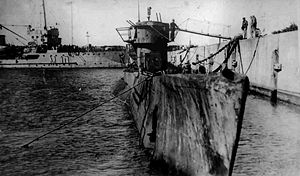This article includes a list of general references, but it lacks sufficient corresponding inline citations. (December 2016) |
 U-977 moored at Mar del Plata naval base
| |
| History | |
|---|---|
| Name | U-977 |
| Ordered | 5 June 1941 |
| Builder | Blohm & Voss, Hamburg |
| Yard number | 177 |
| Laid down | 24 July 1942 |
| Launched | 31 March 1943 |
| Commissioned | 6 May 1943 |
| Captured | Surrendered to Argentine Navy on 17 August 1945 at Mar del Plata, Argentina |
| Fate | Sunk by torpedo from USS Atule during torpedo trials on 13 November 1946 |
| General characteristics | |
| Class and type | Type VIIC submarine |
| Displacement | |
| Length |
|
| Beam |
|
| Draught | 4.74 m (15.6 ft) |
| Propulsion |
|
| Speed |
|
| Range |
|
| Test depth | Calculated crush depth: 220 m (720 ft) |
| Complement | 4 officers, 40–56 enlisted |
| Armament |
|
| Service record | |
| Part of: |
|
| Identification codes: | M 51 994 |
| Commanders: | |
| Operations: |
|
| Victories: | None |
German submarine U-977 was a World War II Type VIIC U-boat of Nazi Germany's Kriegsmarine which escaped to Argentina after Germany's surrender. The submarine's voyage to Argentina led to legends, apocryphal stories and conspiracy theories that it and U-530 had transported escaping Nazi leaders (such as Adolf Hitler) and/or Nazi gold to South America, that it had made a secret voyage to Antarctica, and even that it sank the Brazilian cruiser Bahia as the last act of the Battle of the Atlantic.[1][2]